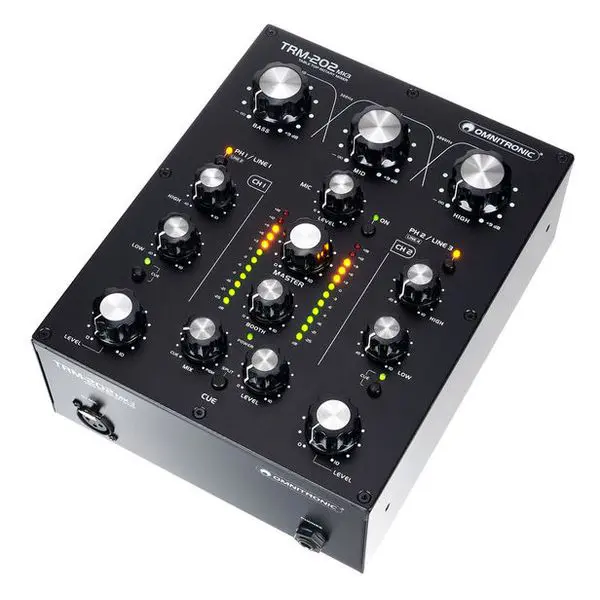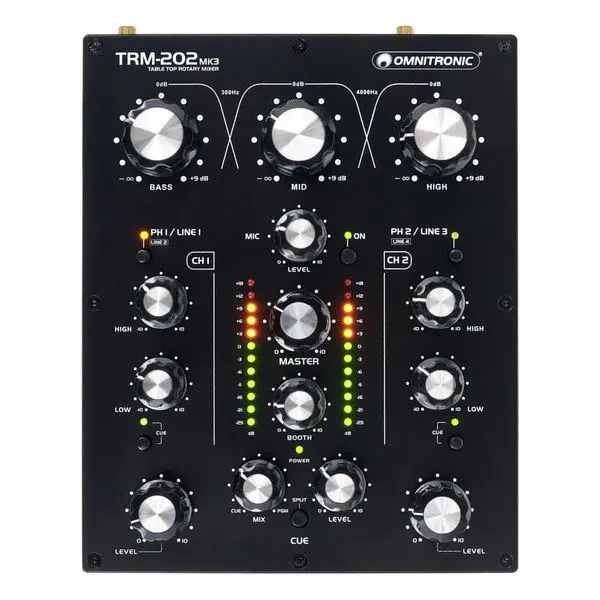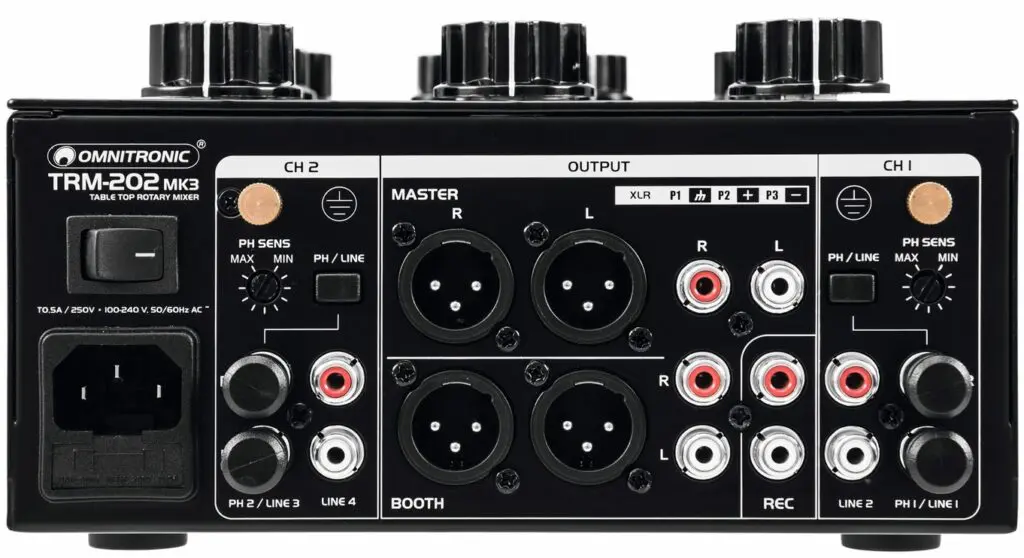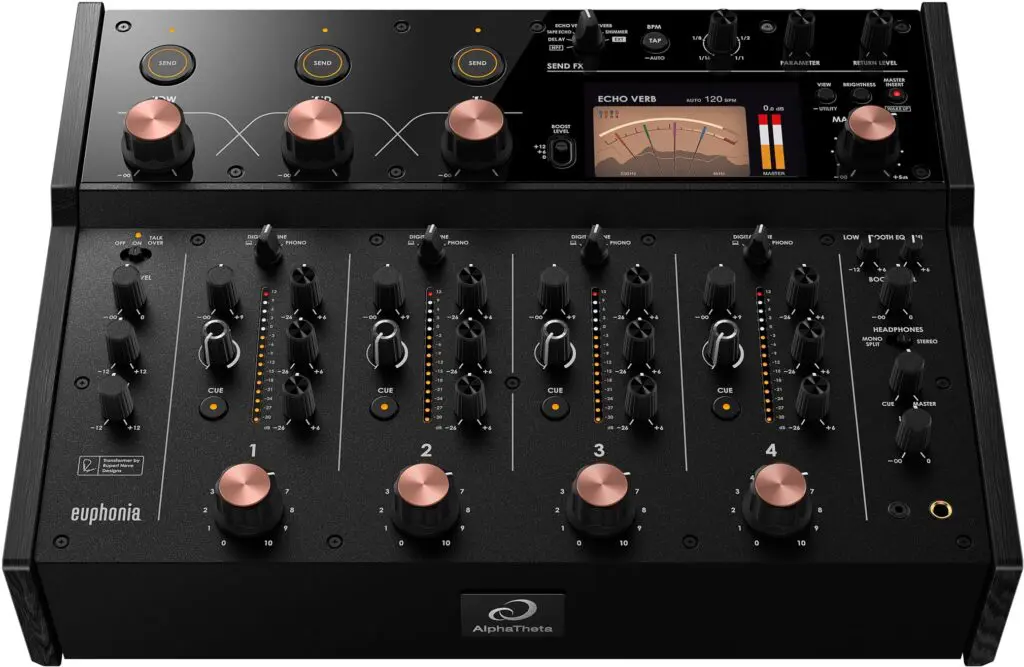
Let’s be honest, getting into the world of rotary mixers can feel like a secret handshake. The high-end boutique mixers from brands like Mastersounds and Condesa are works of art, but they often come with price tags that might require you selling a kidney. This is exactly where Omnitronic’s TRM-202 MK3 swoops in to save the day. It’s widely celebrated as the ultimate entry point, the best-value hero for anyone looking to dip their toes into the magic of rotary mixing without breaking the bank.
So, how do they do it? It’s a beautiful, and frankly brilliant, act of strategic simplicity. Omnitronic didn’t try to replicate everything. They focused on the one thing that truly defines a great rotary mixer: the feel. They built their mixer around the legendary ALPS “Blue Velvet RK27” potentiometers. These are the very same components you’ll find in mixers that cost thousands more , and they give the Omnitronic series a premium, “smooth as butter” feel that completely defies its price. This smart decision lets them deliver what one user perfectly described as “75% of the sound and build quality of an E&S at 15% of the price”. It’s not just a mixer; it’s a gateway drug to a whole new world of mixing.
Getting Hands-On with the TRM-202 MK3
The TRM-202 MK3 is the foundational 2-channel mixer in the lineup, and right out of the box, it feels incredibly solid. The metal housing doesn’t feel “cheap” at all , and its minimalist, stylish design looks great in any setup. It’s got a solid, robust feel that makes you want to get your hands on those big, beautiful knobs. Physically, it measures approximately 190 mm in width by 250 mm in depth, with a height of 107 mm , and weighs in at a sturdy 2.68 kg to 3 kg.
The Heart of the Machine
The core of the experience, as we’ve established, is those ALPS “Blue Velvet RK27” potentiometers, which are crucial for achieving that “precise and smooth mixing” we all crave. And let’s not forget the 3-band frequency isolator. It’s not just a simple EQ; it has a “kill cut” function that lets you completely drop the lows, mids, and highs for dramatic, creative mixing. The technical specs are no joke, with Butterworth curves and crossover points at 300 Hz and 4000 Hz, each with a slope of 18 dB/octave.
The Good, the Bad, and the Vinyl
In terms of connectivity, it’s a dream for its class. You get two stereo channels with switchable line/phono RCA inputs and an XLR mic input. Outputs are just as flexible, with balanced Master and Booth connections (XLR/RCA) and a dedicated Record Out for capturing your mixes. The headphone output is adjustable and even includes a cue mix/split function, which is a lifesaver for pre-fader listening.

But here’s a small dose of reality for the vinyl purists. In a decision that perfectly illustrates the trade-off between form and function, the phono gain controls are on the back of the unit. To keep that sleek, minimalist top panel, you have to sacrifice the ability to quickly tweak the gain for records with different loudness levels. For some, this is an inconvenience, but for others, it’s a blessing in disguise. It forces you to get off the visual and start relying on your ears and the LED meters to get your levels just right, encouraging a more attentive, intuitive mixing style.
The Truth Behind the Hype: A Dose of Reality
While the love for the Omnitronic TRM-202 MK3 is strong, a truly honest review must also address the bumps in the road. This is where the story gets a little more complex.
The Sound Quality Debate
For many, the sound is a revelation. One user was so impressed with their TRM-202 that they sold their Pioneer DJM 900 and Xone 92 because the Omnitronic “blew it out of the water”. Another user claims the TRM-202 offered “damn good” performance and that they “really didn’t hear much difference” between it and a high-end Mastersounds mixer. This is emotional, subjective praise at its highest.
However, a more critical perspective paints a different picture. A technical review notes that the mixer is “definitely not transparent” and its distortion levels put it in the “coloring mixers” category. A professional DJ who uses a Condesa mixer for club gigs claims the Omnitronic “feels bad and sounds bad on club systems” and completely lacks the “warmth” and “punch” of boutique gear. The phono preamps are another point of contention; one user found them “good enough” , while another noticed a “huge improvement” with an external preamp.
The Analogue Lottery
Build quality is generally considered solid for the price , but it’s not without its reported issues. Some users have experienced frustrating signal loss on channels, which one source attributed to a faulty chip that needed to be replaced by the manufacturer. Another widely discussed issue is a “clicking” or “popping” noise when the filter is engaged. While one reviewer notes this is common on many analogue mixers , it can still be a dealbreaker depending on your style. The most emotional feedback comes from users who have had to send their units back for repair or replacement, with some advising others to “avoid omni forever”.

These wildly different experiences – from “flawless” to “terrible mixer” – suggest what some have dubbed the “analogue lottery.” It’s an unspoken risk that comes with the low price point. Some units are truly incredible bargains, while others may have subtle manufacturing flaws. It’s a risk you should be aware of, but for many, it’s a risk well worth taking.
Comparative Analysis: Omnitronic vs. The Market
To understand the Omnitronic’s place in the universe, you have to look at its rivals. It’s not just a product; it’s a disruption.
Head-to-Head with the Budget Contenders
In the budget tier, the Headliner R-series (R2 and R4) is the closest competitor. The TRM-202, at around $277 , has a clear price advantage over the Headliner R2 at $399 . This shows that while Omnitronic wins on sheer value, other budget options might offer a different feature set that’s right for you.
The Mid-Tier Step-Up
The Ecler WARM2, priced around $625 , is a common comparison point for the TRM-202. Users who’ve made the jump feel it’s a “definite upgrade in terms of sound and build quality,” with a firmer feel and an effects send/return loop. This is the sweet spot where a little more money buys a noticeable leap in quality and features.
The Boutique Dream
The most telling comparisons are the ones to the mixers Omnitronic isn’t even trying to compete with: the high-end boutique brands like Mastersounds and Condesa, which can run from over $1,395 to over $4,090. The fact that these comparisons are even made is a testament to Omnitronic’s success.
The ultimate takeaway is this: the Omnitronic’s value is all about context. The claim of “75% at 15%” holds true for the home studio or the serious hobbyist. For a professional DJ playing on a massive club system, the subtle nuances in sound, the lack of “punch,” and the overall feel will be more apparent, justifying the cost of a boutique mixer. The Omnitronic is not a professional club mixer; it’s a gateway, an unbeatable value for someone who wants to experience the magic of rotary mixing without having to sell a kidney to get there.
Core Technical Specifications
Under the hood, the specs speak for themselves. The frequency range is listed as 20 Hz to 20,000 Hz for line/mic and 40 Hz to 18,000 Hz for phono. The signal-to-noise ratio is impressive for the price, with values of >77 dB for phono, >80 dB for the mic, and >85 dB for line inputs. Total harmonic distortion (THD) is measured at less than 0.03% for line and less than 0.1% for phono, which means a clean, powerful signal.
Comparison to other Budget Mixer Competitors
| Feature | Omnitronic TRM-202 MK3 | Ecler WARM2 | Headliner R2 |
| Price | ~$277 | ~$625 | ~$399 |
| Channels | 2 | 2 | 2 |
| EQ | 2-band | 3-band | 3-band |
| Isolator | 3-band | 3-band | 3-band |
| FX Send | No | Yes | No |
| Key Components | ALPS RK27 | ALPS RK27 | NA |
| Pros (User-Reported) | Excellent value; smooth pots | Great sound/build; FX send | Affordable; good value |
| Cons (User-Reported) | Potential QC issues; no FX send | Higher price; pots can be close | Limited feature |
Final Verdict: A Beautiful Trade-Off
So, where do you stand? The Omnitronic TRM-202 MK3 is not just a piece of equipment; it is a statement. It proves that you don’t need to break the bank to find the soul in your mix. It is a triumph of value, built on the strategic use of premium components that deliver an authentic, high-end feel at a price point that is frankly unbelievable.
But let’s be real, it’s not a perfect unicorn. There’s a slight risk of inconsistent quality control, which can lead to frustrating issues , and the design choices, while stylish, can introduce minor workflow quirks.
Here’s the straight talk for you, the DJs:
- For the Home Enthusiast: This is your perfect entry point. It’s a fun, engaging learning curve that will refresh your entire mixing style. It’s a pure analog experience that is simply an unbeatable value.
- For the Mobile DJ or Club Stand-in: The balanced XLR outputs and separate booth control make this mixer perfectly usable in a live setting, and the record output is a convenient feature for capturing mixes. Just be aware of the minor quality control risks, and you’ve got a killer, budget-friendly setup.
- For the Professional or Audiophile: This mixer is not your main weapon for a club gig. While it can be a fantastic backup or a beloved home practice mixer, the subtle yet critical differences in sound will be noticeable on a high-end system.
In the end, the Omnitronic TRM-202 MK3 is a beautiful trade-off. It’s a love letter to the classic rotary mixer, democratizing a once-exclusive experience and making it accessible to anyone who wants to feel the music, one smooth knob turn at a time. It’s a gamble, maybe, but for the right DJ, it’s a bet that pays off in pure, analog gold.

